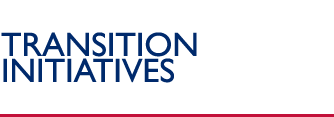Frequently Asked Questions
In which countries is OTI active?
See the list of OTI's active programs.
What is OTI's budget?
For FY2008, OTI received $44 million in Transition Initiative funds.
How does OTI decide where it will engage?
See OTI's Criteria for Engagement.
Who makes the request for OTI to work in a particular country?
Requests for OTI assistance come from a variety of sources, including U.S. Ambassadors, USAID Mission Directors, USAID Regional Bureaus, U.S. Department of State offices, etc. However, it is not necessary for a formal request to be made for the Office to engage.
Why does OTI stay in countries for such a short time?
OTI was designed to fill the gap between relief and long-term development. The average OTI country program is between two to three years. This short-term presence also ensures that OTI resources are available for new transition opportunities and that OTI does not replicate work that USAID Missions and others can do.
Where does OTI get its money?
OTI receives its core funding from the "Transition Initiatives" account. OTI also manages funds that are transferred from other accounts (DA, DFA, ESF, supplementals) in support of its programs.
How does OTI decide what to do in a particular country?
Once OTI decides to engage in a country, OTI develops a program that is uniquely tailored to the country and the political situation.
Who implements OTI programs?
OTI is highly operational, placing staff in the field to design, manage and monitor programs. Generally, OTI seeks to support small, grassroots organizations that are conducting innovative transition activities. To do this, OTI usually cooperates with an implementing partner -- either a U.S. PVO, an international organization, or a contractor -- who handles grant administration, logistics and financial management.
What is SWIFT and how does it work?
"Support Which Implements Fast Transitions" ("SWIFT") is an Indefinite Quantity Contract (IQC) that allows OTI to rapidly establish offices, hire staff, and disburse small grants to local organizations in priority conflict-prone countries.
How does OTI know when it is having an impact?
OTI uses several tools to track its impact, including quarterly analytical field reports and a customized grants database. OTI also measures the speed and flexibility of its programs, the resources it can leverage from other sources, and its influence on U.S. or host-country policy. All OTI country programs review their programs on a regular basis, and participate in internal reviews with OTI senior management. Within the first three months of starting a new program, and periodically throughout the duration of the program, the country teams conduct regular strategy review sessions. OTI also conducts final evaluations at the end of each country program.
How does OTI coordinate with USAID and other USG partners?
OTI recognizes that coordination with its partners at all levels is critical to the success of its programs and to the achievement of U.S. foreign policy goals. Both in Washington and the field, OTI staff are committed to developing close working relationships with their colleagues in USAID, the Department of State, the Department of Defense, the National Security Council, etc. Through these partnerships, OTI has been able to complement and build upon larger U.S. foreign policy objectives, bringing its unique and versatile tools to bear.
What does OTI do with its programs when it leaves a country?
OTI formulates a hand-over strategy for each country program. The strategy indicates which activities will be completed when OTI leaves, and identifies prospective donors for those activities which will require continuation.
Hand-over partners include USAID Missions, other U.S. government agencies, other bilateral donors, host governments, and U.S. or local NGOs, foundations and corporations.
|


